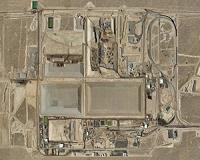 |
Pasadena CA (JPL) Nov 24, 2010 In the first comprehensive global survey of temperature trends in major lakes, NASA researchers determined Earth's largest lakes have warmed during the past 25 years in response to climate change. Researchers Philipp Schneider and Simon Hook of NASA's Jet Propulsion Laboratory in Pasadena, Calif., used satellite data to measure the surface temperatures of 167 large lakes worldwide. They reported an average warming rate of 0.45 degrees Celsius (0.81 degrees Fahrenheit) per decade, with some lakes warming as much as 1 degree Celsius (1.8 degrees Fahrenheit) per decade. The warming trend was global, and the greatest increases were in the mid- to high-latitudes of the Northern Hemisphere. "Our analysis provides a new, independent data source for assessing the impact of climate change over land around the world," said Schneider, lead author of the study published this week in the journal Geophysical Research Letters. "The results have implications for lake ecosystems, which can be adversely affected by even small water temperature changes." Small changes in water temperature can result in algal blooms that can make a lake toxic to fish or result in the introduction of non-native species that change the lake's natural ecosystem. Scientists have long used air temperature measurements taken near Earth's surface to compute warming trends. More recently, scientists have supplemented these measurements with thermal infrared satellite data that can be used to provide a comprehensive, accurate view of how surface temperatures are changing worldwide. The NASA researchers used thermal infrared imagery from National Oceanic and Atmospheric Administration and European Space Agency satellites. They focused on summer temperatures (July to September in the Northern Hemisphere and January to March in the Southern Hemisphere) because of the difficulty in collecting data in seasons when lakes are ice-covered and/or often hidden by clouds. Only nighttime data were used in the study. The bodies studied were selected from a global database of lakes and wetlands based on size (typically at least 500 square kilometers - 193 square miles - or larger) or other unique characteristics of scientific merit. The selected lakes also had to have large surface areas located away from shorelines, so land influences did not interfere with the measurements. Satellite lake data were collected from the point farthest from any shoreline. The largest and most consistent area of warming was northern Europe. The warming trend was slightly weaker in southeastern Europe, around the Black and Caspian seas and Kazakhstan. The trends increased slightly farther east in Siberia, Mongolia and northern China. In North America, trends were slightly higher in the southwest United States than in the Great Lakes region. Warming was weaker in the tropics and in the mid-latitudes of the Southern Hemisphere. The results were consistent with the expected changes associated with global warming. The satellite temperature trends largely agreed with trends measured by nine buoys in the Great Lakes, Earth's largest group of freshwater lakes in terms of total surface area and volume. The lake temperature trends were also in agreement with independent surface air temperature data from NASA's Goddard Institute for Space Studies in New York. In certain regions, such as the Great Lakes and northern Europe, water bodies appear to be warming more quickly than surrounding air temperature.
Share This Article With Planet Earth
Related Links - Earth Observation News - Suppiliers, Technology and Application
 Imaging Science Offers New Opportunities For Interdisciplinary Collaboration
Imaging Science Offers New Opportunities For Interdisciplinary CollaborationWashington DC (SPX) Nov 24, 2010 More than 170 participants gathered this week for the eighth annual National Academies Keck Futures Initiative (NAKFI) conference in Irvine, Calif. This year's topic, imaging science, a field of study that uses physics, chemistry, mathematics, computer science, and cognitive sciences to understand the many factors that influence and enable image capture and analysis. At the conference, top ... read more |
|
| The content herein, unless otherwise known to be public domain, are Copyright 1995-2010 - SpaceDaily. AFP and UPI Wire Stories are copyright Agence France-Presse and United Press International. ESA Portal Reports are copyright European Space Agency. All NASA sourced material is public domain. Additional copyrights may apply in whole or part to other bona fide parties. Advertising does not imply endorsement,agreement or approval of any opinions, statements or information provided by SpaceDaily on any Web page published or hosted by SpaceDaily. Privacy Statement |